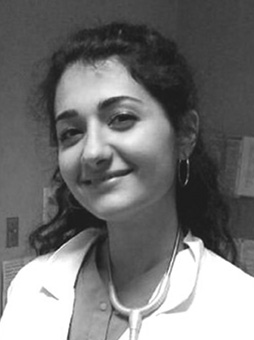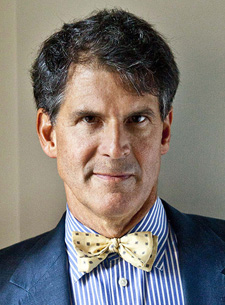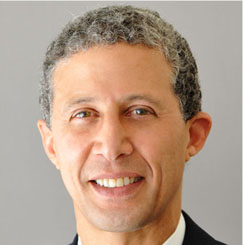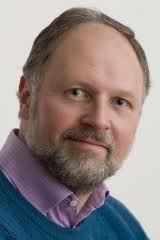Altered States of Consciousness
Printed in the Winter 2015 issue of Quest magazine.
Citation: Abbasova, Parvin."Altered States of Consciousness" Quest 103.1 (Winter 2015): pg. 24-26.
 The first time I learned about altered states of consciousness (ASCs) from official medicine was in my last year of medical school. We had just started our cycle of lectures on psychiatry and psychotherapy. Professor X seemed to be boring, and as the lecture didn't promise much, I was about to start reading my favorite book on yoga. But surprisingly, he opened with a story about a patient who had come to his practice after being treated by an Altai shaman with long-distance hypnosis, a method that enables a practitioner to hypnotize a patient without being physically present. Needless to say, he captured the attention of the audience. He went on to discuss street hypnosis (often used by gypsies), trance and trancelike states, meditation, and even clairvoyance. This was the first time anyone in our university had spoken about such unusual and controversial subjects. By that time I had already studied yoga long enough to know about the five states of mind described by the sage Vyasa in his commentary on the Yoga Sutras, as well as the states of consciousness described as svapna, jagrat, sushupti, and turiya, which correspond to the states of waking, dreaming, dreamless sleep, and pure consciousness respectively. But the thought of actually researching and scientifically explaining this ancient knowledge was a turning point for me, and it led me to choose psychiatry as my specialty.
The first time I learned about altered states of consciousness (ASCs) from official medicine was in my last year of medical school. We had just started our cycle of lectures on psychiatry and psychotherapy. Professor X seemed to be boring, and as the lecture didn't promise much, I was about to start reading my favorite book on yoga. But surprisingly, he opened with a story about a patient who had come to his practice after being treated by an Altai shaman with long-distance hypnosis, a method that enables a practitioner to hypnotize a patient without being physically present. Needless to say, he captured the attention of the audience. He went on to discuss street hypnosis (often used by gypsies), trance and trancelike states, meditation, and even clairvoyance. This was the first time anyone in our university had spoken about such unusual and controversial subjects. By that time I had already studied yoga long enough to know about the five states of mind described by the sage Vyasa in his commentary on the Yoga Sutras, as well as the states of consciousness described as svapna, jagrat, sushupti, and turiya, which correspond to the states of waking, dreaming, dreamless sleep, and pure consciousness respectively. But the thought of actually researching and scientifically explaining this ancient knowledge was a turning point for me, and it led me to choose psychiatry as my specialty.
Today, as in ancient times, people are fascinated by the possibility of altering the "normal" state of consciousness. Modern science and philosophy agree, acknowledging that ASCs are a special type of mental phenomenon. They have also come to realize that it is not possible to draw a solid line between normal or base states and ASCs: not only is there no agreed-upon definition of "normal" in these circumstances, but there are an innumerable variety of ways in which psychic processes work in individuals.
Nevertheless, scientists have come up with classifications of altered states, and many of these have proved helpful for our understanding of this difficult subject.
First, ASCs vary in depth, form, and content. They can include a wide spectrum of psychic phenomena from rapid sleep to deep hypnosis and from hallucinations to psychosis.
Second, the causes of ASCs can be physiological (deep breathing, childbirth), psychological (stress), pathological (delirium, schizophrenia), and even intellectual (as we see from the use of the koan in Zen Buddhism). ASCs can also be caused by chemical substances such as LSD and marijuana.
Third, the alteration between normal and altered states can be spontaneous (road hypnosis), induced by lack of external stimuli (isolation) or by sensory overload hypnotherapy), or self-induced (meditation, self-hypnosis).
ASCs are a basic human need. And, yes, you have experienced them to a certain degree. Have you ever caught yourself zoning out in a bus, not remembering the stations that you have passed or the people that sat next to you? This is considered to be an instance of spontaneous trance. Some researchers have called it an introverted state of consciousness, as opposed to the extraverted basic state. In the introverted state the attention is turned inward, and the psyche processes information that has been generated within itself rather than coming in from the outside world. As described by psychologist Charles Tart, "this condition of my mind feels radically different from some other condition, rather than just an extension of it" (emphasis Tart's).
Other scientists, psychiatrists, and psychologists have tried to shed some light on this gray area of our lives. Among the most famous is Dr. Stanislav Grof, who studied expanded states of consciousness first using LSD and later using holotropic breathwork, which, according to Grof's Web site, "combines accelerated breathing with evocative music in a special set and setting" to engender ASCs. Grof has divided these states into four distinct categories:
Sensory and somatic: consisting of experiences including hallucinations or visualizing images or geometrical patterns. Subjects undergo a variety of sensations, such as numbness of the hands, tingling, and cold or heat. They may spontaneously assume certain postures or even dance. Some report feeling energy blocked or flowing in the body.
Biographical and individual unconscious: As in traditional psychotherapy, this is the level of repressed memories, unresolved problems, and traumas. The interaction with the unconscious is more on a level of awareness and experience than of intellectualization or remembering.
Perinatal: Reliving the birth process and the trauma associated with it.
Transpersonal: This includes, but is not limited to, remembering past lives, identification with other forms of life such as animals (totems), uniting with Universal Mind, and out-of-body experiences.
One of the most important and revolutionary studies in this area was conducted by Dr. A. Kasamatsu and Dr. T. Hirai in 1990. On one occasion they monitored a group of Buddhist monks on a seventy-two-hour pilgrimage to a mountain. The monks were not allowed to speak, drink, or eat. They were exposed to cold weather. After forty-eight hours, the monks started seeing visions of ancestors and feeling their presence.
The purpose of the study was to investigate how sensory deprivation affects the brain. The scientists found that deprivation increases amounts of serotonin"”a hormone that is responsible for sleep, arousal level, and emotion. The highest amounts were in the frontal cortex and hypothalamus, producing visions.
On another occasion the scientists investigated the psychophysiological effects of meditation among Zen Buddhists using electroencephalography (EEG), which measures electrical activity in different areas of the brain. EEGs were recorded continuously before, during, and after Zen meditation. The following results were obtained:
Alpha waves were observed within fifty seconds after the monks began meditation. This occurred whether or not their eyes were open. Alpha waves are generated in the brain when we are relaxed, usually with closed eyes, but are awake and not tired. This state is used widely in biofeedback training, as there is evidence that it helps to overcome phobias and anxiety and calms hyperactive children. During the Zen meditation, these alpha waves followed a specific pattern. After they appeared, their amplitude increased, then decreased, followed by the rhythmical theta train (a period of activity of theta waves).
Theta rhythm is not fully understood by science, but there are two types. The first one, the hippocampal, can be observed in most animals and humans, whereas the other, the cortical type, is specific to humans only. The cortical theta rhythm is often recorded in young children. In adults it is a sign of meditation, drowsiness, or sleep (but not deep sleep). It can also indicate a transition from sleep as well as a quiet wakeful state. Zen masters generated theta rhythms faster than their disciples.
In this process, the left hemisphere of the brain was the first one to become active; then the right one came to dominate; finally, at the deepest state of meditation, the activity of both hemispheres decreased. At this state the subject gains access to problems and ideas rooted in the unconscious, as well as transpersonal problems, and is able to work on them.
After meditation, the general activity of the cortex was higher, while the activity of the limbic system decreased. This means that the individual has heightened awareness and perception, along with a lowered emotional response to both external and internal stimuli. This is called "skilled response."
These studies have proved what Buddhists and yogis have known for thousands of years: ASCs achieved through meditation, pranayama (controlled breathing), or asanas (yogic body postures) change the way the mind functions (on both physiological and biochemical levels) and are ultimately the way to remove suffering (that is, emotional response to pain or trauma).
Let us now look at the subtle changes that occur during ASCs. Certain techniques are aimed toward specific issues, whereas others produce generalized effects. I will take yoga as an example, although similar effects are produced during meditation, chanting, and even tribal dance. In my clairvoyant investigations over the years, I have noticed energetic changes in the auras of yoga students during the asana practice and pranayama, but most importantly during savasana (the "corpse pose," taken as a final form of relaxation). The practice of asana activates the chakras and nadis (energy channels). At this point, anything that blocks the flow of energy can be removed, restoring the natural order. Pranayama and bandhas (energy locks) raise energy up the sushumna, or central spinal channel. Nadi shodhan pranayama (alternate nostril breathing) synchronizes the operation of the two hemispheres, decreasing the activity of the emotions. Finally, savasana induces a state of trance in which the rhythm of vibration and the pulsations of aura become harmonious. Mental images are not generated (although they can be picked up from higher planes). All these things give the yogi a sense of deep relaxation of body and mind.
Lately there have been debates about the effects of psychedelic drugs, marijuana in particular, on consciousness. Proponents of the drug are trying to prove that it produces a relaxation that is necessary to relieve everyday stress. Pseudo-yogis and certain religious sects claim that the use of this substance is essential for uniting with the Divine. From my own psychiatric and clairvoyant experience, however, I would say that the truth is obvious: laziness and weakness lie at the root of such speculations. This claim can be confirmed by reading the clairvoyant observations by Dora Kunz, past president of the Theosophical Society, of people using alcohol and drugs.
People who are not able to develop spiritual discipline and practice are always looking for an easier way. I would include workshops for breathwork, hypnosis, and trance dance in the same category. Because facilitators of these programs use ancient yogic techniques out of context in response to Western culture's demands for fast results in a short time, they cause addiction to the modality or substance and create a dependence on the therapist or instructor. Especially if the spiritual vision of the therapist is clouded or insufficiently developed, there is more risk than benefit from producing ASCs in these ways.
ASCs are very helpful in personal evolution. But they were never meant to be an escape from the problems of everyday reality, as they have become today. Buddhism, yoga, and other ancient spiritual schools have never considered it acceptable to run away from the hardship of the world. Nor was kundalini raised in weekend workshops. Independent, centered, devoted practice has always been central to spiritual growth. Agreeing with Annie Besant, I would suggest thinking about this question: "If you can't face the challenges of the outer world, how can you expect to face the dangers on the path of inner evolution?"
PYARVIN ABBASOVA, M.D., was born and raised in Siberia. She is a psychiatrist and yoga teacher, and has been a member of the Theosophical Society since 2009. She has been a longtime volunteer at Pumpkin Hollow Retreat Center, where she is currently a resident.


 Eben Alexander: I've spent more than twenty years in academic neurosurgery and thought I had some idea of how brain-mind consciousness worked. I fully logged into the reductive materialistic mindset of neuroscience of the twentieth century, which that says there is something about the neurons of the brain and their firing that gives you consciousness. Even though nobody had a clue of how that worked, I thought we just needed to study it more and figure it out.
Eben Alexander: I've spent more than twenty years in academic neurosurgery and thought I had some idea of how brain-mind consciousness worked. I fully logged into the reductive materialistic mindset of neuroscience of the twentieth century, which that says there is something about the neurons of the brain and their firing that gives you consciousness. Even though nobody had a clue of how that worked, I thought we just needed to study it more and figure it out. When I was twenty years old I unexpectedly found myself in contact with a number of psychically sensitive people. I had not sought them out. Before making their acquaintance I had not known anything about them or what they did. I was in college at the time and had never given much thought to the whole subject of psychic perception.
When I was twenty years old I unexpectedly found myself in contact with a number of psychically sensitive people. I had not sought them out. Before making their acquaintance I had not known anything about them or what they did. I was in college at the time and had never given much thought to the whole subject of psychic perception. Few spiritual issues are as vexed as psychedelics. Theosophy, like most esoteric schools, has generally condemned them. Pablo Sender and Pyarvin Abbasova ably state this position in this issue.
Few spiritual issues are as vexed as psychedelics. Theosophy, like most esoteric schools, has generally condemned them. Pablo Sender and Pyarvin Abbasova ably state this position in this issue.